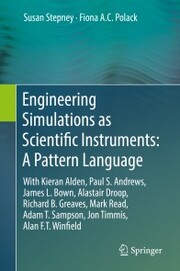Detailansicht
Engineering Simulations as Scientific Instruments: A Pattern Language
eBook - With Kieran Alden, Paul S. Andrews, James L. Bown, Alastair Droop, Richard B. Greaves, Mark Read, Adam T. Sampson, Jon Timmis, Alan F.T. Winfield
ISBN/EAN: 9783030019389
Umbreit-Nr.: 5890903
Sprache:
Englisch
Umfang: 0 S., 4.71 MB
Format in cm:
Einband:
Keine Angabe
Erschienen am 01.11.2018
Auflage: 1/2018
E-Book
Format: PDF
DRM: Digitales Wasserzeichen
- Zusatztext
- <p>This book describes CoSMoS (Complex Systems Modelling and Simulation), a pattern-based approach to engineering trustworthy simulations that are both scientifically useful to the researcher and scientifically credible to third parties. This approach emphasises three key aspects to this development of a simulation as a scientific instrument: the use of explicit models to capture the scientific domain, the engineered simulation platform, and the experimental results of running simulations; the use of arguments to provide evidence that the scientific instrument is fit for purpose; and the close co-working of domain scientists and simulation software engineers.</p><p>In Part I the authors provide a managerial overview: the rationale for and benefits of using the CoSMoS approach, and a small worked example to demonstrate it in action. Part II is a catalogue of the core patterns. Part III lists more specific helper patterns, showing possible routes to a simulation. Finally Part IV documents CellBranch, a substantial case study developed using the CoSMoS approach.</p>
- Kurztext
- This book describes CoSMoS (Complex Systems Modelling and Simulation), a pattern-based approach to engineering trustworthy simulations that are both scientifically useful to the researcher and scientifically credible to third parties. This approach emphasises three key aspects to this development of a simulation as a scientific instrument: the use of explicit models to capture the scientific domain, the engineered simulation platform, and the experimental results of running simulations; the use of arguments to provide evidence that the scientific instrument is fit for purpose; and the close co-working of domain scientists and simulation software engineers.In Part I the authors provide a managerial overview: the rationale for and benefits of using the CoSMoS approach, and a small worked example to demonstrate it in action. Part II is a catalogue of the core patterns. Part III lists more specific &quote;helper&quote; patterns, showing possible routes to a simulation. Finally Part IV documents CellBranch, a substantial case study developed using the CoSMoS approach.
